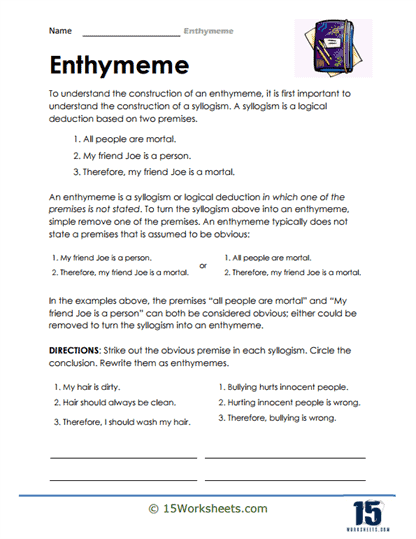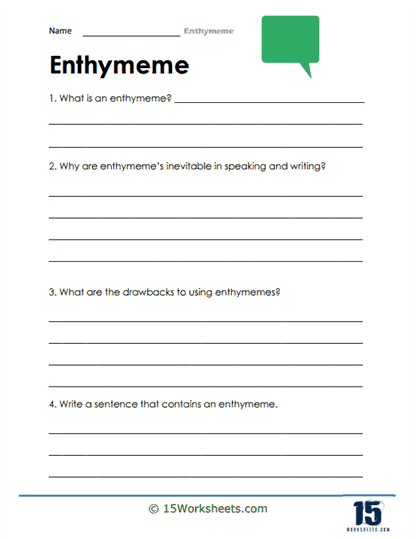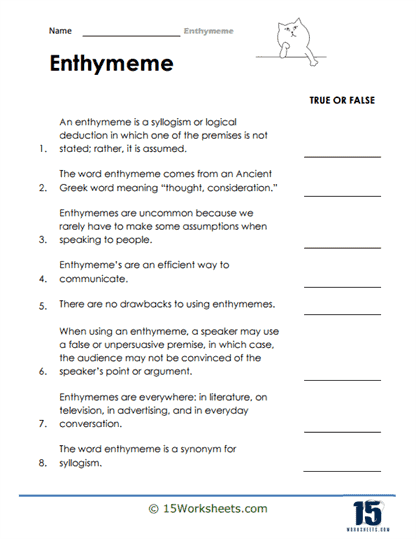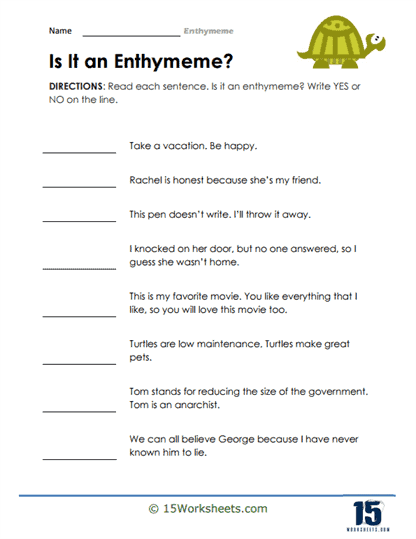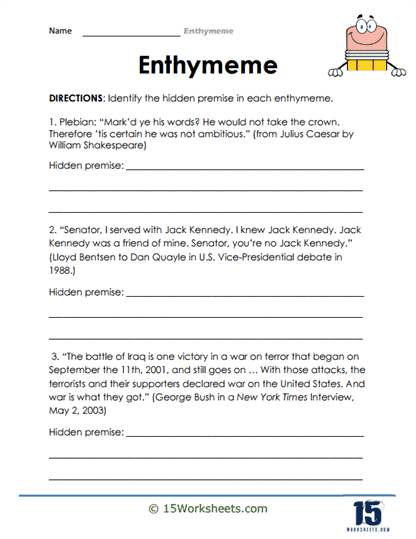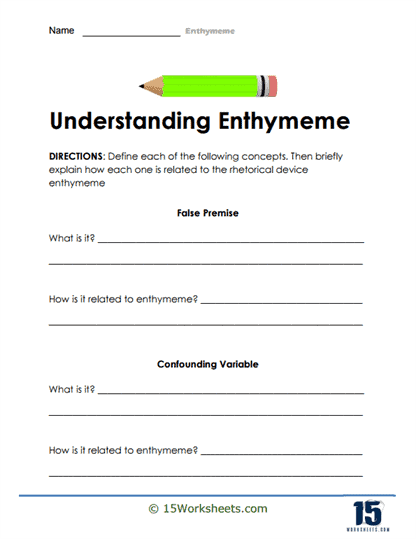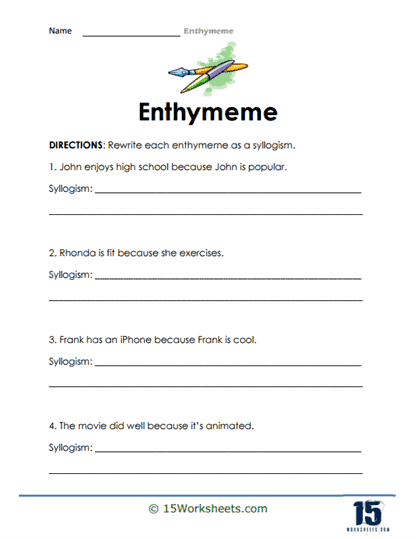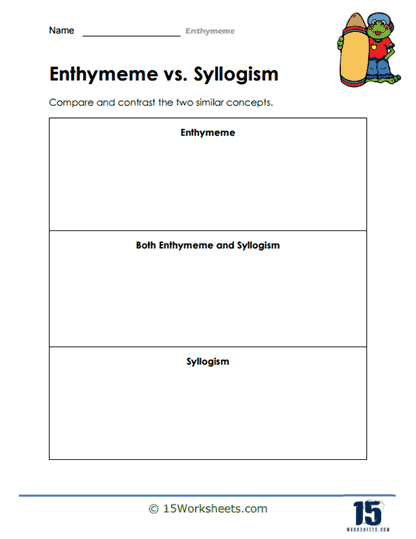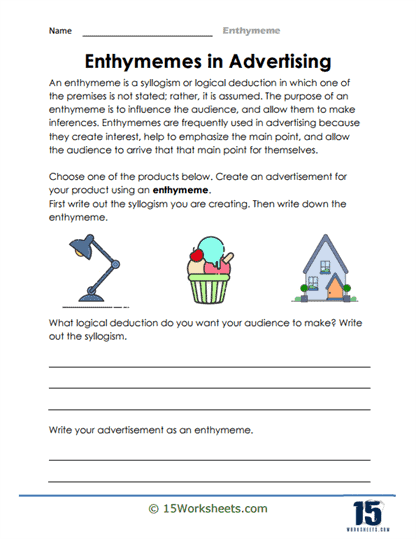Enthymeme Worksheets
All About These 15 Worksheets
The concept of enthymeme, a rhetorical device that involves a truncated syllogism or argument with a missing premise, has been a fundamental element of persuasive communication for centuries. Understanding and recognizing enthymemes are critical skills in fields like rhetoric, debate, critical thinking, and effective communication. This collection of 15 worksheets is designed to introduce students to the world of enthymeme, helping them grasp its importance, identify its usage, and harness its power in their own discourse and reasoning.
What Are Enythmeme Worksheets?
Enthymeme worksheets will help students understand and practice the concept of “enthymemes.” An enthymeme is a type of argument that is often used in rhetoric where one of the premises, or the conclusion, is not explicitly stated but is assumed. Essentially, it’s an argument with an unstated assumption that the listener or reader is expected to understand.
These worksheets aim to strengthen the students’ critical thinking, comprehension, and reasoning abilities by helping them identify and understand the use of enthymemes in various contexts.
What Types of Activities Will You Find On These Worksheets
Identification – These exercises present students with a variety of sentences or arguments and ask them to identify the enthymeme. For example, a statement like “Socrates is mortal because he’s human” leaves out the general premise that “all humans are mortal.” Students would be expected to identify this unstated assumption.
Completion – These exercises provide students with partial arguments, and they must complete them by supplying the missing premise or conclusion. For instance, if given the statement “Since all men are mortal, …” students might be expected to complete it with something like “… Socrates is mortal.”
Creation – These exercises require students to create their own enthymemes. They might be given a general topic or specific guidelines, but the goal would be to create an argument where one of the premises or the conclusion isn’t stated but is understood.
Real-world Examples – These exercises could involve identifying or analyzing enthymemes in real-world contexts, such as political speeches, advertisements, or social media posts. This can help students see the practical applications and everyday occurrences of this concept.
By working with enthymemes, students learn to be more discerning in their interpretation and creation of arguments, better understanding the ways that people communicate and how our assumptions and context fill in gaps in information.
What is the Literary Device of Enthymeme?
An enthymeme is a unique and critical element in the realm of rhetoric and argumentation. Coined by Aristotle, the term “enthymeme” refers to an argument where one premise is not explicitly stated. In other words, it’s a syllogism (a logical argument presenting two or more propositions (premises) that logically lead to a conclusion) with one or more suppressed premises. These missing parts are left for the audience to fill in based on their knowledge or assumptions, giving the enthymeme its defining feature of implicitness.
In literature, authors use enthymemes to engage readers more deeply by prompting them to deduce the unstated parts of an argument, thereby stimulating their critical thinking. The use of enthymemes can make narratives more compelling and dialogues more realistic, as they mirror the way people often communicate in real life – we don’t always spell everything out but rely on shared knowledge and understandings.
Main Defining Feature of an Enthymeme
The central feature of an enthymeme is its incompleteness – the fact that it leaves out a premise or conclusion. This distinguishing aspect sets it apart from a regular syllogism, which explicitly states all its premises and conclusion. For instance, a syllogism might say, “All men are mortal. Socrates is a man. Therefore, Socrates is mortal.” In contrast, an enthymeme would present the same argument as “Socrates is a man, so he is mortal,” leaving the audience to infer the general premise that all men are mortal.
Examples of Enthymemes in Literature
“Pride and Prejudice” by Jane Austen
Early in Austen’s novel, the narrator states – “It is a truth universally acknowledged, that a single man in possession of a good fortune, must be in want of a wife.” The enthymeme here is that wealthy, single men necessarily desire to marry, which isn’t explicitly reasoned out but is left for readers to infer from societal norms and expectations of the period.
“Moby-Dick” by Herman Melville
In Melville’s “Moby-Dick,” Captain Ahab, obsessed with hunting the white whale, says, “He tasks me; he heaps me; I see in him outrageous strength, with an inscrutable malice sinewing it.” The enthymeme here lies in the implied reasoning that because the whale (Moby-Dick) causes him trouble and appears malicious, it must be pursued and defeated.
“The Great Gatsby” by F. Scott Fitzgerald
In Fitzgerald’s novel, one of the characters, Daisy, makes an observation about her daughter – “I hope she’ll be a fool – that’s the best thing a girl can be in this world, a beautiful little fool.” The underlying, unstated assumption here is that the world is such a difficult place for women that it’s better to be a “beautiful fool” than to understand and be hurt by reality.
Each of these examples presents an enthymeme through the words and thoughts of characters. In these instances, the authors use enthymemes not just to reflect realistic speech patterns but also to provide insights into the characters’ perspectives and the societal contexts in which they exist. By leaving parts of the argument unsaid, they engage readers in active interpretation, enhancing their connection with the story and deepening their understanding of the themes.

